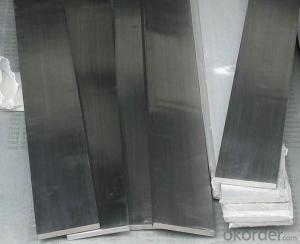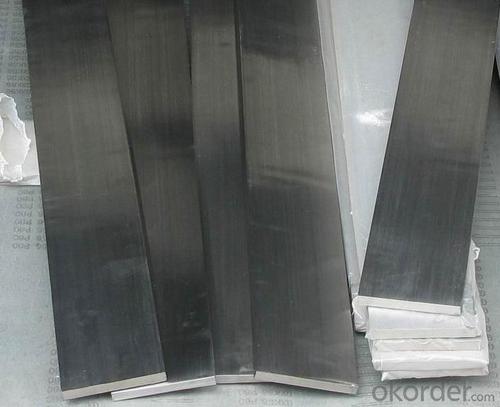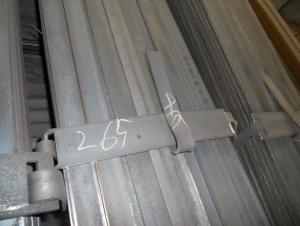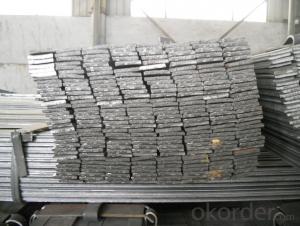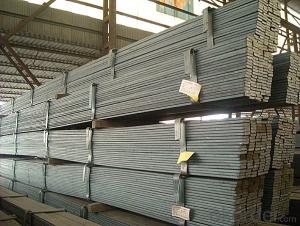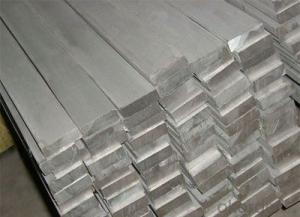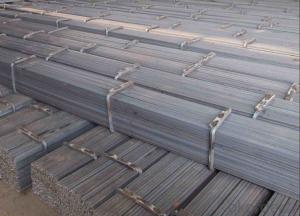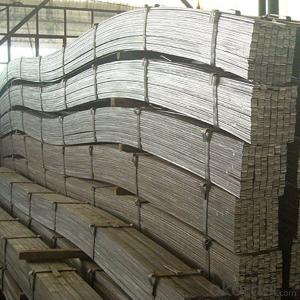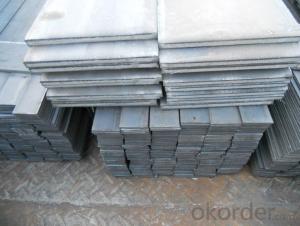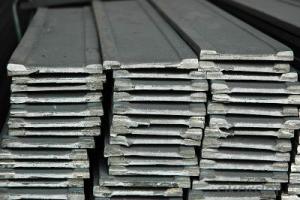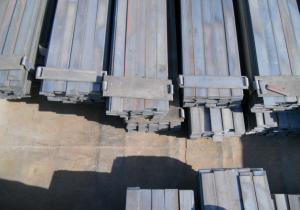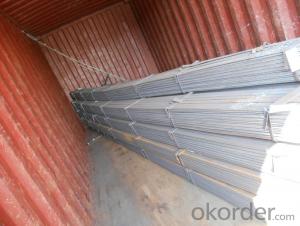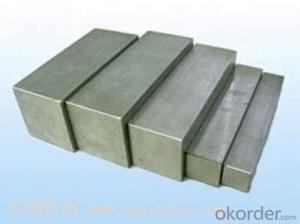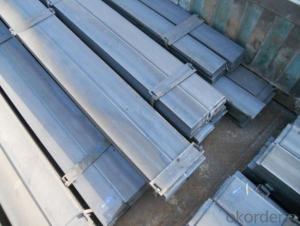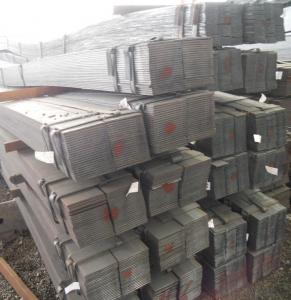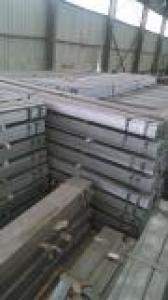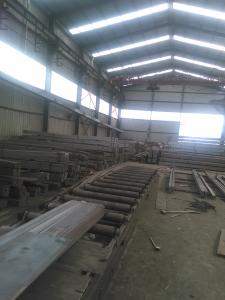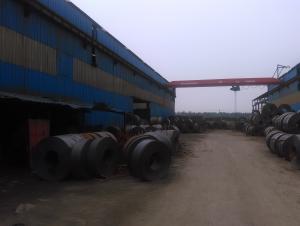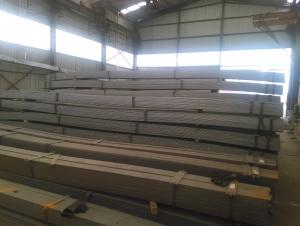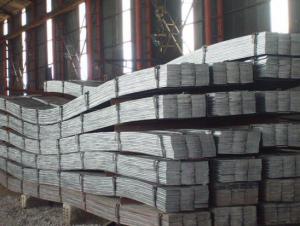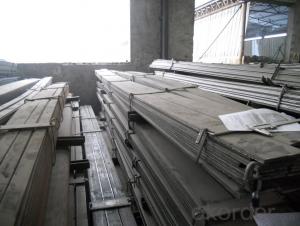HIGH QUALITY FLAT BAR Q235
- Loading Port:
- China Main Port
- Payment Terms:
- TT OR LC
- Min Order Qty:
- -
- Supply Capability:
- -
OKorder Service Pledge
OKorder Financial Service
You Might Also Like
Flat bar Details:
| Minimum Order Quantity: | | Unit: | m.t. | Loading Port: | |
| Supply Ability: | 10000 | Payment Terms: | | Package: | Steel Packing |
Product Description:
Product Description:
Specification of Mild Steel Flat Bar
Commodity: Mild Steel Flat Bar
Standard: GB;JIS
Material: Q195-235;SS400
Brand name: FLATSPACE
Origin place: China
Thickness: 3mm-30mm
Width:20mm-200mm
Length: Max 12m
Certification: SGS/BV
Chemical composition of Q235
Alloy No | Grade | Element(%) | ||||
C
| Mn
| S
| P
| Si
| ||
Q235
|
B
|
0.12—0.20 |
0.3—0.7 |
≤0.045 |
≤0.045
|
≤0.3
|
Physical properties of Q235
Alloy No | Grade | Yielding strength point(Mpa) | Tensile strength (Mpa) | Elongation after fracture(%) | ||||||
Thickness (mm) | Thickness (mm) | |||||||||
≤16 | >16--40 | >40--60 | >60--100 |
| ≤16 | >16--40 | >40--60 | >60--100 | ||
≥ | ≥ | |||||||||
Q235 |
B |
235 |
225 |
215 |
205 |
375--500 |
26 |
25 |
24 |
23 |
Usage/Applications of Mild Steel Flat Bar
Widely used for construction, Machinery manufacturing, Iron tower steel structure, Shipbuilding; Steel grating, Staircase, Bridge, Viaduct, Railway spare parts, Boilers making etc.
Packaging & Delivery of Mild Steel Flat Bar
Packaging Details: The Mild Steel Flat Bars are packed in bundles and loaded in 20 feet/40 feet container, or shipped by bulk cargo ,also we can do as customer's requirements.
Delivery Details:30~45 days upon the receipt of buyer payment by T.T. or L/C.
Production Flow of Mild Steel Flat Bar
The Mild steel flat bar is made through three processes:
1.Feeding the material: Feeding the row material (the steel plate) to Slitting Line.
2.Slitting:The steel plate would be slitted into expected width by lengthways cutter.
3. Leveled and cutting: The plat bar would be ground into level by the grinder and then cut into required length
- Q: How do steel flat bars compare to aluminum flat bars?
- Steel flat bars and aluminum flat bars possess distinct properties and characteristics, rendering them appropriate for diverse applications. Regarding strength, steel flat bars generally exhibit a greater degree of robustness compared to aluminum flat bars. Steel is a denser and harder material, endowing it with superior tensile strength and rendering it less susceptible to deformation or bending under pressure. Consequently, steel flat bars are the preferred choice for applications demanding high load-bearing capacity or structural support. Conversely, aluminum flat bars are considerably lighter than their steel counterparts. Aluminum boasts a lower density, thereby conferring upon it a lightweight quality. This feature renders aluminum flat bars more manageable and transportable, particularly in applications where weight is a significant concern, such as in the aerospace or automotive industry. Another crucial factor to consider is corrosion resistance. Aluminum naturally forms an oxide layer, which imparts exceptional resistance to corrosion, rendering it ideal for outdoor applications or environments characterized by high levels of moisture or humidity. Conversely, steel is prone to rust and corrosion unless adequately coated or protected. As a result, steel flat bars are better suited for indoor applications or areas with minimal exposure to moisture. Lastly, cost represents an additional consideration. Generally, steel flat bars tend to be more cost-effective than aluminum flat bars. Steel is a widely available and economical material, while the production and processing of aluminum can incur greater expenses. In conclusion, steel flat bars offer greater strength and durability, qualifying them for heavy-duty applications and structural support. In contrast, aluminum flat bars are lighter, exhibit greater resistance to corrosion, and are better suited for applications where weight plays a pivotal role. Ultimately, the choice between steel and aluminum flat bars hinges upon the specific requirements of the application, taking into account factors such as strength, weight, corrosion resistance, and cost.
- Q: Are steel flat bars used in the aerospace industry?
- Yes, steel flat bars are used in the aerospace industry. They are commonly used for various applications such as structural components, support brackets, and fittings due to their strength, durability, and ability to withstand high temperatures.
- Q: What are the different types of surface defects in brass steel flat bars?
- Brass steel flat bars can have several types of surface defects, which can occur during the manufacturing, processing, or handling of the material. Some common surface defects in brass steel flat bars include: 1. Scratches: These are shallow marks or abrasions on the surface of the flat bar, which can be caused by mishandling, contact with sharp objects, or improper storage. Scratches can affect the appearance of the bar and potentially weaken its structural integrity. 2. Pitting: Pitting refers to small, localized cavities or depressions on the surface of the flat bar. It can occur due to exposure to corrosive environments or chemical reactions. Pitting can compromise the surface smoothness and may lead to further corrosion if left untreated. 3. Rust or corrosion: Brass steel flat bars can develop rust or corrosion when exposed to moisture, humidity, or aggressive chemicals. Rust appears as a reddish-brown coating on the surface and can weaken the bar over time. Corrosion can also lead to pitting or flaking of the surface. 4. Dents or dings: Dents or dings are small deformations or indentations on the surface of the flat bar. These defects can occur during handling or transportation, especially if the bars are not adequately protected. Dents may not impact the structural integrity significantly but can affect the overall appearance. 5. Roll marks: Roll marks are surface imperfections that occur during the rolling process used to shape the brass steel flat bars. These marks can appear as ridges, depressions, or patterns on the surface. While they may not affect the functionality of the bar, they can impact the aesthetic appeal. 6. Scale: Scale refers to the layer of oxides that forms on the surface of brass steel flat bars during heating or high-temperature processes. Scale appears as a thin, flaky coating that can be easily removed by mechanical means. While scale does not affect the structural integrity, it can impact the surface finish. It is important to note that surface defects can vary in severity, and some defects may be acceptable depending on the specific application or industry standards. Regular inspection, proper handling, and appropriate surface treatment methods can help mitigate and prevent these surface defects in brass steel flat bars.
- Q: Can steel flat bars be used for making construction equipment or vehicles?
- Yes, steel flat bars can be used for making construction equipment or vehicles. Steel flat bars are versatile and commonly used in various industries, including construction and automotive. They offer high strength, durability, and excellent load-bearing capabilities, making them suitable for manufacturing heavy-duty equipment and vehicles. Steel flat bars can be shaped, cut, and welded to meet specific design requirements, allowing for the creation of custom components and structures. Additionally, their corrosion-resistant properties ensure longevity, making them a reliable choice for construction equipment and vehicles subjected to harsh environments and heavy use. Overall, steel flat bars are a popular material for construction and automotive applications due to their strength, versatility, and reliability.
- Q: Are steel flat bars suitable for the construction of retail spaces or shopping centers?
- Certainly! Steel flat bars are a suitable option when constructing retail spaces or shopping centers. Their strength, durability, and versatility make them widely used in the construction industry. Framing, support beams, and decorative elements are just a few of the many purposes they can serve. Structurally, steel flat bars provide excellent support and can handle heavy loads, which makes them perfect for large commercial spaces like shopping centers. They are also resistant to fire, corrosion, and pests, ensuring a long lifespan and minimal maintenance. Moreover, steel flat bars can be easily customized and fabricated to meet specific design requirements. They can be cut, welded, and shaped into different forms, giving flexibility to architectural designs. In addition, steel is a sustainable and environmentally-friendly material as it can be recycled and reused. This aspect makes it an appealing choice for retail spaces or shopping centers that wish to embrace green building practices and reduce their environmental impact. All in all, steel flat bars offer a range of benefits in terms of strength, durability, versatility, and sustainability, making them a suitable and advantageous choice for constructing retail spaces or shopping centers.
- Q: What are the typical applications of steel flat bars?
- Due to their versatility and strength, steel flat bars find a wide range of applications in various industries. In the construction sector, they are commonly used for structural support in buildings and bridges. The manufacturing industry also relies heavily on steel flat bars, utilizing them in the production of machinery, equipment, and tools. In the automotive industry, steel flat bars are frequently employed in the construction of chassis, frames, and body structures due to their excellent strength and durability. They are also extensively used in the fabrication of agricultural equipment like plows and harrows, as they can withstand heavy loads and harsh environments. The marine industry also heavily relies on steel flat bars. They are used in the construction of ship hulls and various marine components such as rudders, propellers, and anchor chains. The corrosion-resistant properties of stainless steel flat bars make them particularly suitable for marine applications. Steel flat bars are also crucial in the manufacturing of furniture, appliances, and storage systems. Their high strength-to-weight ratio allows for the creation of lightweight yet robust structures. Additionally, they are commonly used in the production of shelving units, brackets, and supports due to their load-bearing capabilities. In summary, steel flat bars have a vast and diverse range of applications in industries including construction, manufacturing, automotive, and marine. Their strength, durability, and versatility make them an indispensable component in various sectors.
- Q: Where can I buy ground level bending machine?
- When lap welding is adopted, the welding length is as follows: 1. Galvanized steel bar is not less than 2 times its width, no less than three surface welding. When the width of flat steel is different, the length of lap should be wide. Before laying, the flat steel should be adjusted straight, simmer, bend not to die, straight line should not be obvious bending, and should stand upright. 2. The length of galvanized round steel shall be no less than 6 times of its diameter, and shall be welded on both sides (when the diameter is different, the lap length shall be of big diameter).
- Q: Are steel flat bars suitable for making brackets or supports for oil and gas pipelines?
- Certainly! Steel flat bars are appropriate for creating brackets or supports for oil and gas pipelines. Steel possesses notable strength and durability, making it an optimal material choice for tasks that demand substantial load-bearing capabilities. Flat bars present a broad surface area for effectively distributing the weight and stress of the pipelines, guaranteeing stability and support. Moreover, steel boasts exceptional resistance against corrosion, which is vital in oil and gas pipelines where exposure to moisture and harsh environments is prevalent. Additionally, it is important to mention that steel flat bars can be readily manufactured and tailored to meet specific design requirements, rendering them exceedingly versatile for diverse pipeline support applications. In summary, steel flat bars offer the essential strength, durability, and corrosion resistance required for fabricating brackets or supports for oil and gas pipelines.
- Q: What are the different finishes available for steel flat bars?
- The different finishes available for steel flat bars include hot rolled, cold finished, and galvanized.
- Q: What are the different shapes available for steel flat bars?
- Steel flat bars come in various shapes to cater to different needs. The most commonly seen shape is the rectangular flat bar, characterized by its straight, flat surface and sharp edges. This particular shape finds frequent use in structural applications like building frames and supports. Another shape available is the square flat bar, which boasts equal width and thickness on all sides, forming a square shape. This shape is often employed for ornamental purposes, such as decorative trim or fencing. Furthermore, one can also find round-edged flat bars, which feature rounded corners instead of sharp edges. This shape is particularly favored in applications where safety is a concern, as the rounded edges minimize the risk of injury or damage. Moreover, certain manufacturers offer special shapes like tapered flat bars or custom profiles, specifically designed to meet particular requirements or provide unique functionality for specific applications. All in all, the assortment of shapes available for steel flat bars offers a wide range of options to accommodate diverse needs and preferences. This allows for versatility and customization across various industries and projects.
Send your message to us
HIGH QUALITY FLAT BAR Q235
- Loading Port:
- China Main Port
- Payment Terms:
- TT OR LC
- Min Order Qty:
- -
- Supply Capability:
- -
OKorder Service Pledge
OKorder Financial Service
Similar products
Hot products
Hot Searches
Related keywords
